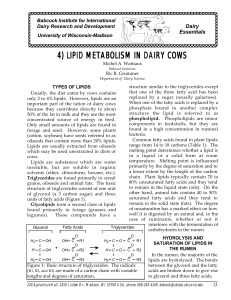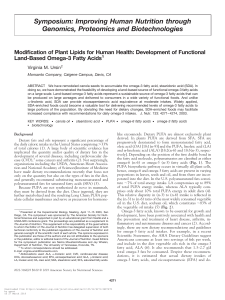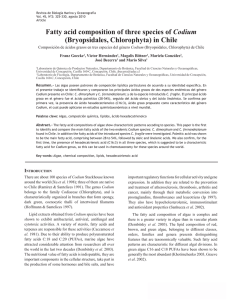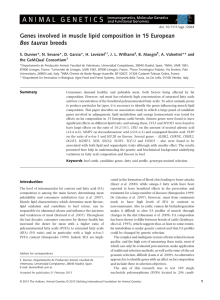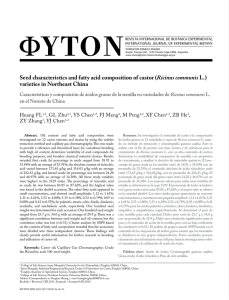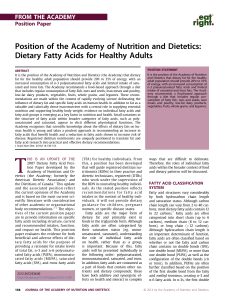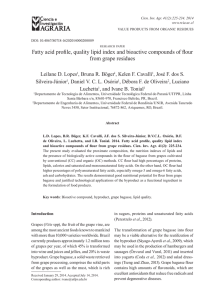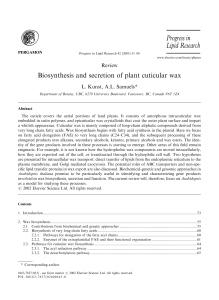Fatty acid composition of hempseed oils from different
Anuncio
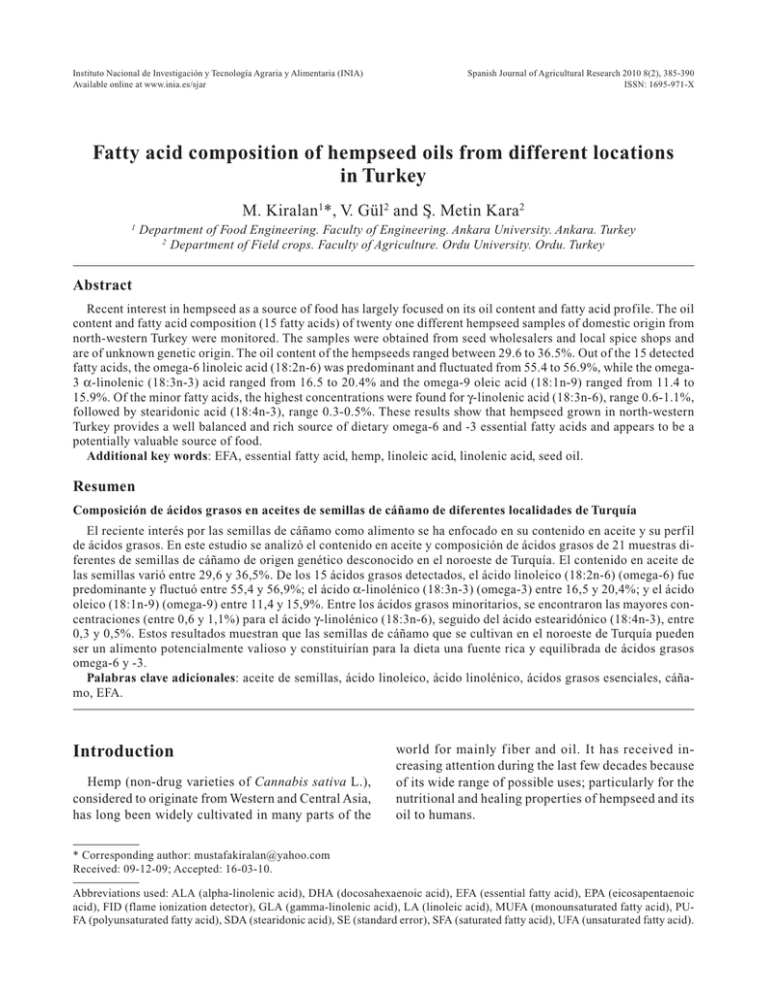
Instituto Nacional de Investigación y Tecnología Agraria y Alimentaria (INIA) Available online at www.inia.es/sjar Spanish Journal of Agricultural Research 2010 8(2), 385-390 ISSN: 1695-971-X Fatty acid composition of hempseed oils from different locations in Turkey M. Kiralan1*, V. Gül2 and Ş. Metin Kara2 1 Department of Food Engineering. Faculty of Engineering. Ankara University. Ankara. Turkey 2 Department of Field crops. Faculty of Agriculture. Ordu University. Ordu. Turkey Abstract Recent interest in hempseed as a source of food has largely focused on its oil content and fatty acid profile. The oil content and fatty acid composition (15 fatty acids) of twenty one different hempseed samples of domestic origin from north-western Turkey were monitored. The samples were obtained from seed wholesalers and local spice shops and are of unknown genetic origin. The oil content of the hempseeds ranged between 29.6 to 36.5%. Out of the 15 detected fatty acids, the omega-6 linoleic acid (18:2n-6) was predominant and fluctuated from 55.4 to 56.9%, while the omega3 α-linolenic (18:3n-3) acid ranged from 16.5 to 20.4% and the omega-9 oleic acid (18:1n-9) ranged from 11.4 to 15.9%. Of the minor fatty acids, the highest concentrations were found for γ-linolenic acid (18:3n-6), range 0.6-1.1%, followed by stearidonic acid (18:4n-3), range 0.3-0.5%. These results show that hempseed grown in north-western Turkey provides a well balanced and rich source of dietary omega-6 and -3 essential fatty acids and appears to be a potentially valuable source of food. Additional key words: EFA, essential fatty acid, hemp, linoleic acid, linolenic acid, seed oil. Resumen Composición de ácidos grasos en aceites de semillas de cáñamo de diferentes localidades de Turquía El reciente interés por las semillas de cáñamo como alimento se ha enfocado en su contenido en aceite y su perfil de ácidos grasos. En este estudio se analizó el contenido en aceite y composición de ácidos grasos de 21 muestras diferentes de semillas de cáñamo de origen genético desconocido en el noroeste de Turquía. El contenido en aceite de las semillas varió entre 29,6 y 36,5%. De los 15 ácidos grasos detectados, el ácido linoleico (18:2n-6) (omega-6) fue predominante y fluctuó entre 55,4 y 56,9%; el ácido α-linolénico (18:3n-3) (omega-3) entre 16,5 y 20,4%; y el ácido oleico (18:1n-9) (omega-9) entre 11,4 y 15,9%. Entre los ácidos grasos minoritarios, se encontraron las mayores concentraciones (entre 0,6 y 1,1%) para el ácido γ-linolénico (18:3n-6), seguido del ácido estearidónico (18:4n-3), entre 0,3 y 0,5%. Estos resultados muestran que las semillas de cáñamo que se cultivan en el noroeste de Turquía pueden ser un alimento potencialmente valioso y constituirían para la dieta una fuente rica y equilibrada de ácidos grasos omega-6 y -3. Palabras clave adicionales: aceite de semillas, ácido linoleico, ácido linolénico, ácidos grasos esenciales, cáñamo, EFA. Introduction Hemp (non-drug varieties of Cannabis sativa L.), considered to originate from Western and Central Asia, has long been widely cultivated in many parts of the world for mainly f iber and oil. It has received increasing attention during the last few decades because of its wide range of possible uses; particularly for the nutritional and healing properties of hempseed and its oil to humans. * Corresponding author: [email protected] Received: 09-12-09; Accepted: 16-03-10. Abbreviations used: ALA (alpha-linolenic acid), DHA (docosahexaenoic acid), EFA (essential fatty acid), EPA (eicosapentaenoic acid), FID (flame ionization detector), GLA (gamma-linolenic acid), LA (linoleic acid), MUFA (monounsaturated fatty acid), PUFA (polyunsaturated fatty acid), SDA (stearidonic acid), SE (standard error), SFA (saturated fatty acid), UFA (unsaturated fatty acid). 386 M. Kiralan et al. / Span J Agric Res (2010) 8(2), 385-390 Hempseed has unique nutritional properties and has commonly been claimed to be one of the most nutritionally complete foods and is truly one of nature’s super foods (Osburn, 1992; Deferne and Pate, 1996). Hempseeds contain all the essential amino acids and essential fatty acids necessary to maintain healthy human life. No other industrial plant seed has such a full amino acid spectrum in such an easily digestible form with the two essential fatty acids (EFAs) in ratio that benefits human nutritional needs (Callaway et al., 1996). Hempseed contains 20-25% protein, 20-30% carbohydrates, 25-35% oil and 10-15% insoluble fiber and a rich array of minerals (Deferne and Pate, 1996; Pate, 1999). The value of hempseed oil from the point of view of the primary components is its fatty acid composition. Hemp is of high nutritional quality because it contains the two dietary essential fatty acids, namely the omega-6 linoleic acid (LA; 18:2n6, 50-60%) and the omega-3 alpha-linolenic acid (ALA; 18:3n3, 20-25%) in the ratio of 3:1, which has been claimed ideal for human nutrition (Simopoulos, 1991, 2002). These two essential fatty acids, comprise up to 80% of total fatty acids of hempseed oil, serve mainly as raw materials for cell structure and as precursors for biosynthesis of many functional metabolites. Hempseed oil is also one of the few botanical sources of gamma-linolenic acid (GLA; 18:3n6) and stearidonic acid (SDA; 18:4n3), which are of increasing pharmaceutical interest, making the nutritional value of hempseed superior to other seed oils (Leizer et al., 2000). Both GLA and SDA act as precursors for the rapid synthesis of longer chain fatty acids, such as eicosanoids, in the human body (Callaway et al., 1996; Guil-Guerrero, 2007). Hempseed, in addition its nutritional value, has demonstrated positive health benefits (Callaway et al., 2005; Schwab et al., 2006) and has traditionally been consumed in folk and folk medicinal preparations, employed as bird and poultry feed, or as a functional food (Oomah et al., 2002). Roasted hempseed, Turkish name is çedene, mixed with roasted bread wheat (Turkish name is kavurga) has long been traditionally used as a snack in countryside of Turkey. The interest in hemp for cosmetic products, particularly skin care, is due to the high content of favorable unsaturated fatty acids in seed of hemp, particularly linoleic, α-linolenic, and γ-linolenic acids, which influence several important cell membrane functions (Vogl et al., 2004). It has been reported that the origin of the seed seems to influence oil content and particularly the fatty acid composition (Ross et al., 1996; Mölleken and Theimer, 1997). In the literature, there are a number of studies indicating appreciable differences among fatty acid compositions of the hempseed oils from variable regions or countries (Leizer et al., 2000; Kriese et al., 2004), or even among samples from the same country (Orhan et al., 2000; Bagci et al., 2003; Anwar et al., 2006). Therefore, the full characterization of hempseed oils of diverse origins still appears to be a sound research priority to obtain a reliable data on this valuable crop. However, studies on oil content and fatty acid composition of hempseed from Turkey are very limited. We thus analyzed twenty one hempseed samples that were produced in north-western Turkey, formerly the most important region for hempseed production. Material and methods Materials Hempseed samples of domestic origin were obtained from seed wholesalers and local spice shops in northwestern Turkey (Taşköprü, Vezirköprü, Ordu, Çorum, Gümüşhacıköy, Samsun and Ereğli provinces or towns) between Lat. 40º30’-41º30’N and Long. 31º25’-37º52’E. This is the most important region for hemp production in Turkey, where there is no registration of hemp varieties, but just local landraces. Then, the genetic origin of samples is unknown. For oil and fatty acid analysis, three different seed samples (a total of 21 seed samples) of 300 g were taken in each of the seven sites. After removing the seed impurities, the seed samples were stored at dark and cooling place until they were analyzed. Methods The seeds (approximately 1 g) were ground and added to 75 mL of hexane. The mixture was then placed in FOSS Soxtec 2055 Apparatus for oil extraction. To determine the fatty acid fraction of each oil sample, fatty acids were esterified to methyl esters (AOAC, 1990) and the resulting solutions were analyzed by Shimadzu (Kyoto, Japan) gas chromatograph equipped with DB23 capillary column (30 m × 0.25 µm) and FID (flame ionization detector). The carrier gas was helium; at a flow rate of 1.0 mL min-1. Injector and detector temperatures were 230 and 240 °C, respectively. Column Fatty acids in Turkish hempseeds temperature was kept at 190°C for 30 min. Samples of 1.0 µL were injected by hand with a split mode (1:80). The fatty acid identification was performed by retention time comparisons with the corresponding fatty acid methyl ester standards. Individual reference methyl ester standards (miristic acid (C14:0), palmitic acid (C16:0), stearic acid (C18:0), oleic acid (C18:1), linoleic acid (C18:2), arachidic acid (C20:0), gadoleic acid (C20:1), behenic acid (C22:0) and lignoceric acid (C24:0) and as well as fatty acid methyl ester mix (37 components FAME mix) were purchased from Sigma Chemical Co. (Sigma-Aldrich GmbH, Sternheim, Germany). Results and discussion In this study twenty one different hempseed samples obtained from seven provinces and/or vicinities in north-western Turkey were subjected to chemical analysis for their oil content and fatty acid composition. The oil contents of the hempseeds, given as means ± SD for the three samples obtained from each site, are presented in Table 1. The oil contents of the hempseed samples ranged from 29.61 to 36.47%, with the average of 32.13%. The highest oil content was measured in the samples received from the town of Gümüşhacıköy, followed by Taşköprü (34.24%), which are temperate regions with a cold winter and hot summer. On the other hand, the lowest value was recorded in the samples from the district of Ereğli, which is a wet region with mild climate. The vicinity of Gümüşhacıköy has previously been well-known for hempseed production of good quality. The values obtained in this study for oil content of the hempseeds in north-western Turkey were within the expected range reported previously for hempseed Table 1. Oil contents of hemp seeds (%, mean ± SE) Samples Taşköprü Vezirköprü Çorum Ereğli Gümüşhacıköy Ordu Samsun SE: standard error. Oil content (%) 34.24 ± 0.36 30.95 ± 0.62 31.55 ± 0.64 29.61 ± 0.01 36.47 ± 0.01 30.78 ± 0.54 31.29 ± 1.67 387 (Deferne and Pate, 1996; Oomah et al., 2002; Kriese et al., 2004). The average oil content (32.13%) was similar to that (31.79%) reported earlier from Turkey (Bagci et al., 2003), but higher than the value (28.87%) reported for hempseeds grown in different agro-ecological regions of Pakistan (Anwar et al., 2006). The oil content values, however, ranged between 35.27 and 36.88% in a study undertaken in north-western Turkey (Ozdemir, 1993). Since the oil content and composition of hemp seeds is largely affected by environmental factors (Ross et al., 1996; Kriese et al., 2004), along with processing and storage methods, differences in oil content and, to a lesser extent, the fatty acid composition of the seeds may be observed among samples even from the same country. The fifteen fatty acids such as myristic, palmitic, palmitoleic, stearic, oleic, linoleic, gama-linolenic, alphalinolenic, stearidonic, arachidic, gadoleic, eicosadienoic, behenic, erucic and lignoceric acid were identified in the oil of the hempseeds monitored. The fatty acid breakdown of the hempseed oils are shown in Table 2. The principal saturated fatty acid in the hempseed samples was palmitic acid (C16:0), one of the most common saturated fatty acids found in animals and plants, ranging between 6.08% and 6.82%. It was followed by stearic acid (C18:0), varying from 2.34% to 2.67%. The amounts of the other saturated fatty acids were below 1%. Arachidic (0.60-0.76%), behenic (0.21-0.25%), lignoceric (0.06-0.12%) and myristic acid (0.03-0.04%) were saturated fatty acids found in trace amounts in all seed samples. The saturated fatty acid fraction represents 9.37-10.57% of the total fatty acids present in hempseeds. This low level of saturation was comparable to those reported in the literature (Ross et al., 1996; Mölleken and Theimer, 1997; Oomah et al., 2002; Bagci et al., 2003; Anwar et al., 2006). Concentrations of palmitic and stearic acid from hempseed oil were within the range reported by Bagci et al. (2003), Parker et al. (2003) and Kriese et al. (2004). Stearic acid, in contrast with palmitic acid, was shown not to raise cholesterol concentration (Grundy, 1994). Oils containing higher stearic acid contents have more desirable physical and chemical properties for food industry (Fernández-Moya et al., 2005; Mensink, 2005) and might be used in place of those high in palmitic acid in cholesterol-lowering diets. However, French et al. (2002) showed that palmitic acid had no hypercholesterolaemic effect if intake of linoleic acid was greater than 4.5% of energy. 388 M. Kiralan et al. / Span J Agric Res (2010) 8(2), 385-390 Table 2. Fatty acid contents of hemp seed oils (%, mean ± SE) C14:0 C16:0 C16:1 C18:0 C18:1 C18:2 C18:3 γ C18:3 α C18:4 C20:0 C20:1 C20:2 C22:0 C22:1 C24:0 SFAs UFAs MUFAs PUFAs Çorum Ereğli Gümüşhacıköy Ordu Samsun Taşköprü Vezirköprü 0.04 ± 0.00 6.44 ± 0.01 0.13 ± 0.03 2.49 ± 0.01 11.40 ± 0.01 56.61 ± 0.08 0.64 ± 0.00 20.40 ± 0.04 0.34 ± 0.01 0.60 ± 0.00 0.39 ± 0.01 0.06 ± 0.01 0.21 ± 0.01 0.16 ± 0.00 0.12 ± 0.04 9.9 90.1 12.1 78.0 0.04 ± 0.00 6.14 ± 0.01 0.13 ± 0.02 2.46 ± 0.01 14.50 ± 0.01 56.23 ± 0.06 1.10 ± 0.01 17.40 ± 0.00 0.47 ± 0.01 0.66 ± 0.01 0.37 ± 0.00 0.05 ± 0.00 0.24 ± 0.01 0.16 ± 0.01 0.10 ± 0.01 9.6 90.4 15.2 75.2 0.03 ± 0.00 6.61 ± 0.01 0.11 ± 0.01 2.67 ± 0.01 15.88 ± 0.02 55.48 ± 0.01 0.82 ± 0.00 16.51 ± 0.01 0.34 ± 0.00 0.75 ± 0.00 0.36 ± 0.01 0.04 ± 0.01 0.25 ± 0.01 0.12 ± 0.01 0.06 ± 0.00 10.4 89.6 16.4 73.2 0.04 ± 0.01 6.08 ± 0.01 0.10 ± 0.01 2.34 ± 0.01 13.38 ± 0.01 56.94 ± 0.01 1.07 ± 0.01 18.20 ± 0.01 0.47 ± 0.00 0.61 ± 0.01 0.32 ± 0.00 0.04 ± 0.00 0.22 ± 0.01 0.15 ± 0.01 0.08 ± 0.01 9.4 90.6 13.9 76.7 0.04 ± 0.00 6.27 ± 0.02 0.12 ± 0.02 2.42 ± 0.00 14.95 ± 0.01 56.40 ± 0.02 1.03 ± 0.00 16.86 ± 0.01 0.41 ± 0.00 0.65 ± 0.00 0.36 ± 0.00 0.05 ± 0.00 0.24 ± 0.00 0.13 ± 0.00 0.09 ± 0.00 9.7 90.3 15.6 74.7 0.04 ± 0.01 6.82 ± 0.09 0.12 ± 0.05 2.64 ± 0.01 14.60 ± 0.04 55.41 ± 0.11 0.83 ± 0.00 17.58 ± 0.05 0.37 ± 0.02 0.76 ± 0.02 0.38 ± 0.04 0.04 ± 0.01 0.23 ± 0.02 0.15 ± 0.01 0.08 ± 0.01 10.6 89.5 15.3 74.2 0.04 ± 0.00 6.46 ± 0.01 0.11 ± 0.01 2.44 ± 0.00 13.20 ± 0.01 56.19 ± 0.03 0.97 ± 0.00 18.58 ± 0.00 0.45 ± 0.01 0.67 ± 0.02 0.37 ± 0.01 0.05 ± 0.00 0.24 ± 0.01 0.18 ± 0.01 0.09 ± 0.01 9.9 90.1 13.9 76.2 SFA: saturated fatty acids. UFA: unsaturated fatty acids. MUFA: monounsaturated fatty acids. PUFA: polyunsaturated fatty acids. The results of the present study revealed that the oils in the hempseed samples from north-western Turkey were high in polyunsaturated fatty acids (89.43-90.63%). Linoleic acid (LA; 18:2n-6), running between 55.41% and 56.94%, was the most abundant unsaturated fatty acid of hempseed oils, followed by α-linolenic (ALA; 18:3n-3) and oleic acid (18:1n-9) with the ranges of 16.51-20.40% and 11.40-15.88%, respectively. These three unsaturated fatty acids, the major fatty acids present in hempseed, comprised 87.59-88.52% of the total fatty acids. It has been reported however that such a high degree of unsaturation makes hempseed oil extremely sensitive to oxidative rancidity, so the oil has a relatively short shelf life (Deferne and Pate, 1996; Callaway, 2004). The range (11.40-15.88%) of oleic acid was similar to those reported earlier (Oomah et al., 2002; Carvalho et al., 2006), but higher than the values reported by Callaway et al. (1996) and Anwar et al. (2006). The contents of linoleic acid in the hempseed oils from north-western Turkey were slightly higher than the values reported by Orhan et al. (2000), Bagci et al. (2003) and Kriese et al. (2004), but lower than those reported by Callaway et al. (1996), Anwar et al. (2006) and Carvalho et al. (2006). It is interesting to note that the range of α-linolenic acid found in the present study was generally lower than those reported earlier in the literature (Callaway et al., 1996; Oomah et al., 2002; Kriese et al., 2004; Anwar et al., 2006), but well in line with that of Carvalho et al. (2006). Similarly, Orhan et al. (2000) and Bagci et al. (2003) reported appreciably higher α-linolenic acid content of hempseed oil from Turkey. The ratio of n-6 to n-3, essential fatty acids that must come from dietary sources, and the total unsaturated to the saturated fatty acids varied from 2.8 to 3.4 and 8.6 to 9.7, respectively. Omega-3 and omega 6 fatty acids are not interconvertible in the human body and are important components of all cell membranes (Simopoulos, 1991). Excessive amounts of omega-6 polyunsaturated fatty acids and a very high omega-6/omega-3 ratio promote the risk of many diseases, including cardiovascular disease, cancer, and inflammatory and autoimmune diseases, whereas increased levels of omega3 PUFA (a low omega-6/omega-3 ratio) exert suppressive effects (Simopoulos, 2002). The other fatty acids (palmitoleic, γ-linolenic, stearidonic, gadoleic, eicosadienoic and erucic acids) were found in small amounts. However, γ-linolenic acid (GLA; 18:3n-6) content, characteristic of hempseed oil with a pharmaceutical interest, was higher among other minor unsaturated fatty acids and varied from 0.64 to 1.10%. It has been well documented (Deferne and Pate, 1996; Mölleken and Theimer, 1997; Callaway, 2004) that the presence of both stearidonic acid (highly unsaturated omega-3) and γ-linolenic acid (highly Fatty acids in Turkish hempseeds unsaturated omega-6) in hempseed oil ultimately makes its nutritional value superior to any other industrial oilseed crop. The γ-linolenic acid content of the hempseed in the present study was significantly lower than those reported by Callaway and Laakkonen (1996), Callaway et al. (1996), Mölleken and Theimer (1997) and Oomah et al. (2002); and was higher than that reported by Bagci et al. (2003), whereas was comparable to the values reported by Parker et al. (2003) and by Anwar et al. (2006). Studies have shown that hempseeds from regions with a mild or warm climate contain small amounts of γ-linolenic acid, whereas hempseeds from temperate or even cold regions have a large amount (Deferne and Pate, 1996; Ross et al., 1996; Mölleken and Theimer, 1997). In the seed samples examined, stearidonic acid (SDA, 18:4n-3) was not in such high percentages as GLA and varied from 0.34 to 0.47%. Although stearidonic acid seems to have a very limited presence in domesticated plants, it may function as an important human dietary component of hempseed oil (Callaway et al., 1996), especially in combination of GLA. Stearidonic acid is a polyunsaturated fatty acid that constitutes the first metabolite of α-linolenic acid in the metabolic pathway leading to longer chain omega-3 fatty acids, eicosapentaenoic acid (EPA; C20:5n-3) and docosahexaenoic acid (DHA; C22:6n-3), which have recently gained much attention (James et al., 2003; Ursin, 2003; NewellMcGloughlin, 2008). The other unsaturated fatty acids such as gadoleic, palmitoleic, eicosadienoic and erucic acids were also identified in all samples within the ranges of 0.32-0.39%, 0.10-0.13%, 0.04-0.06% and 0.12-0.18%, respectively. In conclusion, the results of this study showed that hempseed in north-western Turkey contains a fatty acid composition of high and well balanced dietary essential fatty acids; thus, it appears to be a potentially valuable source of food. Furthermore, in accordance with the recently acquired knowledge concerning hempseed oil, these f indings could be a valuable contribution in obtaining a reliable data on various occurrences of fatty acids, dietary essential fatty acids in particular, among hempseeds of various regions. Acknowledgements The authors are greateful for the financial and technical support of Ordu University (Ordu, Turkey) and Ankara University (Ankara, Turkey). 389 References ANWAR F., LATIF S., ASHRAF M., 2006. Analytical characterization of hemp (Cannabis sativa L.) seed oil from different agro-ecological zones of Pakistan. JAOCS 83, 323-329. AOAC, 1990. Fatty acids in oil and fats. In: Official methods of analysis (Helrich K., ed), 15 th ed. AOAC: Arlington, VA, USA. Volume 2, pp. 963-964. BAGCI E., BRUEHL L., AITZETMULLER K., ALTAN Y., 2003. A chemotaxonomic approach to the fatty acid and tocochromanol content of Cannabis sativa L. (Cannabaceae). Turk J Bot 27, 141-147. CALLAWAY J.C., 2004. Hempseed as a nutritional resource: an overview. Euphytica 140, 67-72. CALLAWAY J.C., LAAKKONEN T.T., 1996. Cultivation of Cannabis oil seed varieties in Finland. J Int Hemp Assoc 3(1), 32-34. CALLAWAY J.C., TENNIL T., PATE D.W., 1996. Occurrence of «omega-3» acid (cis-6,9,12,15-octadecatetraenoic acid) in hemp (Cannabis sativa L.). J Int Hemp Assoc 3(2), 61-63. CALLAWAY J.C., SCHWAB U., HARVIMAA I., HALONEN P., MYKKÄNEN O., HYVÖNEN P., JÄRVINEN T., 2005. Efficacy of dietary hempseed oil in patients with atopic dermatitis. J Dermatol Treat 16, 87-94. CARVALHO L.S., MIRANDA I., PEREIRA H., 2006. Evaluation of oil composition of some crops suitable for human nutrition. Ind Crop Prod 24(1), 75-78. DEFERNE J.L., PATE D.W., 1996. Hemp seed oil: a source of valuable essential fatty acids. J Int Hemp Assoc 3(1), 4-7. FERNÁNDEZ-MOYA V., MARTÍNEZ-FOCE E., GARCÉS R., 2005. Oils from improved high stearic acid sunflower seeds. Agric Food Chem 53(13), 5326-5330. FRENCH M.A., SUNDRAM K., CLANDININ M.T., 2002. Cholesterolaemic effect of palmitic acid in relation to other dietary fatty acids. Asia Pac J Clin Nutr 11(7), 401-407. GRUNDY S.M., 1994. Influence of stearic acid on cholesterol metabolism relative to other long-chain fatty acids. Am J Clin Nutr 60, 986-990. GUIL-GUERRERO J.L., 2007. Stearidonic acid (18:4n-3): metabolism, nutritional importance, medical uses and natural sources. Eur J Lipid Sci Tech 109(12), 1226-1236. JAMES M.J., URSIN V.M., CLELAND L.G., 2003. Metabolism of stearidonic acid in human subjects: comparison with the metabolism of other n-3 fatty acids. Am J Clin Nutr 77(5), 1140-1145. KRIESE U., SCHUMANN E., WEBER W.E., BEYER M., BRÜHL L., MATTHÄUS B., 2004. Oil content, tocopherol composition and fatty acid patterns of the seeds of 51 Cannabis sativa L. genotypes. Euphytica 137, 339-351. LEIZER C., RIBNICKY D., POULEV A., DUSHENKOV S., RASKIN I., 2000. The composition of hemp seed oil and its potential as an important source of nutrition. J Nutraceut Funct Med Foods 2(4), 35-53. 390 M. Kiralan et al. / Span J Agric Res (2010) 8(2), 385-390 MENSINK R.P., 2005. Effects of stearic acid on plasma lipid and lipoproteins in humans. Lipids 40, 1201-1205. MÖLLEKEN H., THEIMER R.R., 1997. Survey of minor fatty acids in Cannabis sativa L. fruits of various origins. J Int Hemp Assoc 4(1), 13-17. NEWELL-MCGLOUGHLIN M., 2008. Nutritionally improved agricultural crops. Plant Physiol 147, 939-953. OOMAH B.D., BUSSON M., GODFREY D.V., DROVER J.C.G., 2002. Characteristics of hemp (Cannabis sativa L.) seed oil. Food Chem 76, 33-43. ORHAN U., KUSMENOGLU S., SENER, B., 2000. GC-MS analysis of the seed oil of Cannabis sativa L. cultivated in Turkey. J Fac Pharm Gazi 17(2), 79-81. OSBURN L., 1992. Hemp seed: the most nutritionally complete food source in the world. Part two: Hemp seed oils and the flow of live force. Hemp Line J 1(2), 12-13. OZDEMIR O., 1993. Azot ve Bitki Sıklığının Kenevirin (Cannabis sativa L.) Verim ve Bazı Özelliklerine Etkisi. Köy Hizmetleri Araştırma Enstitüsü Müdürlüğü No: 78, Samsun. [In Turkish]. PARKER T.D., ADAMS D.A., ZHOU K., HARIS M., YU L., 2003. Fatty acid composition and oxidative stability of cold-pressed edible seed oils. J Food Sci 68(4), 12401243. PATE D.W., 1999. Hemp seed: a valuable food source. In: Advances in hemp research (Ranali P., ed). The Haworth Press, Binghamton, NY. pp. 243-255. ROSS S.A., ELSOHLY H.N., KASHOURY E.A., ELSOHLY M., 1996. Fatty acids of Cannabis seeds. Phytochem Anal 7, 279-283. SCHWAB U., CALLAWAY J., ERKKILÄ A., GYNTHER J., UUSITUPA M., JÄRVINEN T., 2006. Effects of hempseed and flaxseed oils on the prof ile of serum lipids, serum total and lipoprotein lipid concentrations and haemostatic. Eur J Nutr 45(8), 470-477. SIMOPOULOS A.P., 1991. Omega-3 fatty acids in health and disease and in growth and development. Am J Clin Nutr 54(3), 438-463. SIMOPOULOS A.P., 2002. The importance of the ratio of omega-6/omega-3 essential fatty acids. Biomed Pharmacother 56(8), 365-379. URSIN V.M., 2003. Modification of plant lipids for human health: development of functional land-based omega-3 fatty acids. J Nutr 133, 4271-4274. VOGL C.R., MÖLLEKEN H., LISSEK-WOLF G., SURBÖCK A., KOBERT J., 2004. Hemp (Cannabis sativa L.) as a resource for green cosmetics: yield of seed and fatty acid composition of 20 varieties under the growing conditions of organic farming in Austria. J Ind Hemp 9(1), 51-68.
